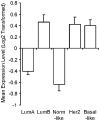An integrated bioinformatics approach identifies elevated cyclin E2 expression and E2F activity as distinct features of tamoxifen resistant breast tumors
- PMID: 21789246
- PMCID: PMC3137633
- DOI: 10.1371/journal.pone.0022274
An integrated bioinformatics approach identifies elevated cyclin E2 expression and E2F activity as distinct features of tamoxifen resistant breast tumors
Abstract
Approximately half of estrogen receptor (ER) positive breast tumors will fail to respond to endocrine therapy. Here we used an integrative bioinformatics approach to analyze three gene expression profiling data sets from breast tumors in an attempt to uncover underlying mechanisms contributing to the development of resistance and potential therapeutic strategies to counteract these mechanisms. Genes that are differentially expressed in tamoxifen resistant vs. sensitive breast tumors were identified from three different publically available microarray datasets. These differentially expressed (DE) genes were analyzed using gene function and gene set enrichment and examined in intrinsic subtypes of breast tumors. The Connectivity Map analysis was utilized to link gene expression profiles of tamoxifen resistant tumors to small molecules and validation studies were carried out in a tamoxifen resistant cell line. Despite little overlap in genes that are differentially expressed in tamoxifen resistant vs. sensitive tumors, a high degree of functional similarity was observed among the three datasets. Tamoxifen resistant tumors displayed enriched expression of genes related to cell cycle and proliferation, as well as elevated activity of E2F transcription factors, and were highly correlated with a Luminal intrinsic subtype. A number of small molecules, including phenothiazines, were found that induced a gene signature in breast cancer cell lines opposite to that found in tamoxifen resistant vs. sensitive tumors and the ability of phenothiazines to down-regulate cyclin E2 and inhibit proliferation of tamoxifen resistant breast cancer cells was validated. Our findings demonstrate that an integrated bioinformatics approach to analyze gene expression profiles from multiple breast tumor datasets can identify important biological pathways and potentially novel therapeutic options for tamoxifen-resistant breast cancers.
Conflict of interest statement
Figures





References
-
- Jordan VC, Murphy CS. Endocrine pharmacology of antiestrogens as antitumor agents. Endocr Rev. 1990;11:578–610. - PubMed
-
- Katzenellenbogen BS, Miller MA, Mullick A, Sheen YY. Antiestrogen action in breast cancer cells: modulation of proliferation and protein synthesis, and interaction with estrogen receptors and additional antiestrogen binding sites. Breast Cancer Res Treat. 1985;5:231–243. - PubMed
-
- Arpino G, De Angelis C, Giuliano M, Giordano A, Falato C, et al. Molecular Mechanism and Clinical Implications of Endocrine Therapy Resistance in Breast Cancer. Oncology. 2009;77:23. - PubMed
-
- Loi S, Haibe-Kains B, Desmedt C, Lallemand F, Tutt AM, et al. Definition of Clinically Distinct Molecular Subtypes in Estrogen Receptor-Positive Breast Carcinomas Through Genomic Grade. J Clin Oncol. 2007;25:1239–1246. - PubMed
Publication types
MeSH terms
Substances
LinkOut - more resources
Full Text Sources
Other Literature Sources
Medical

